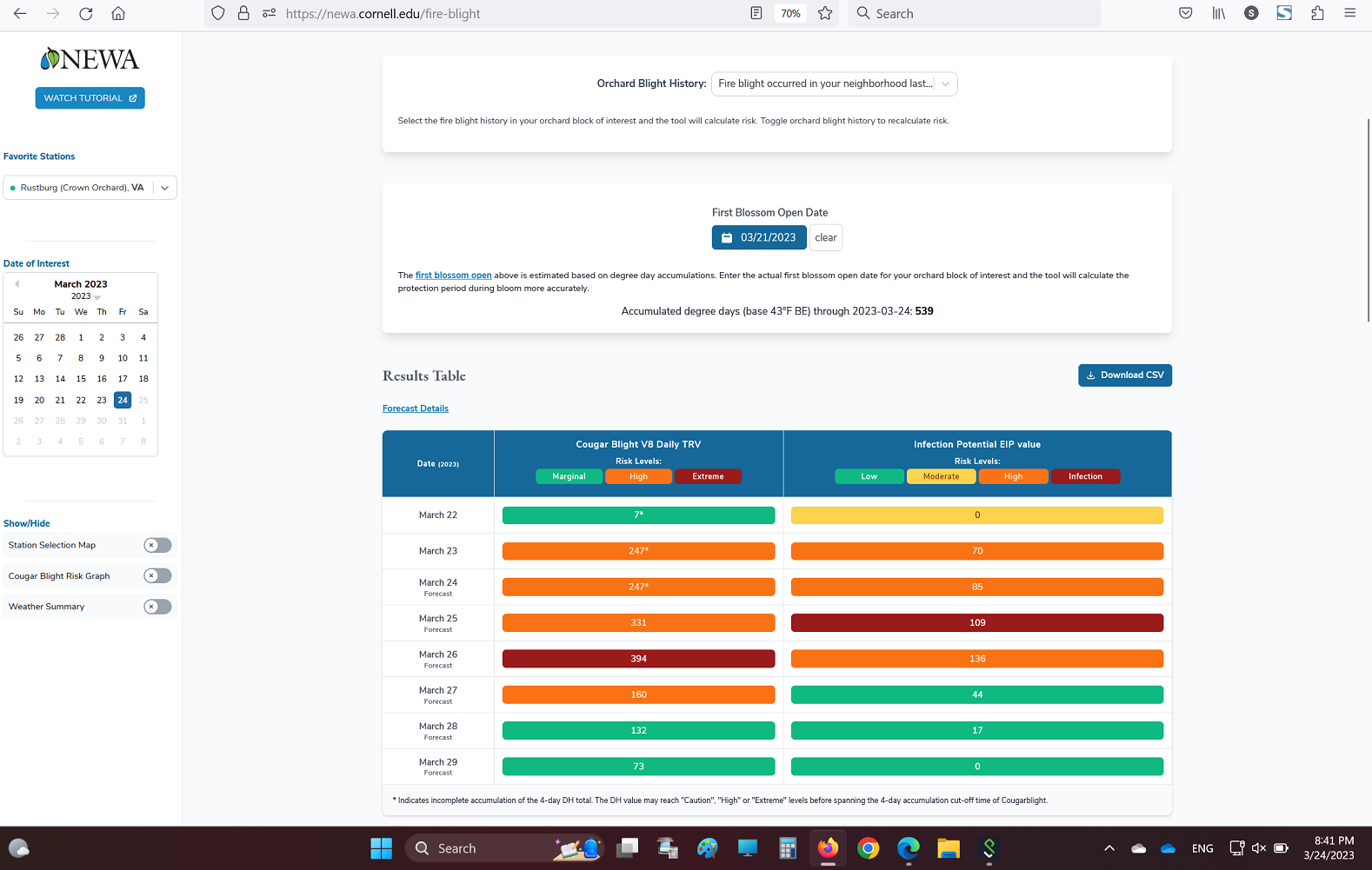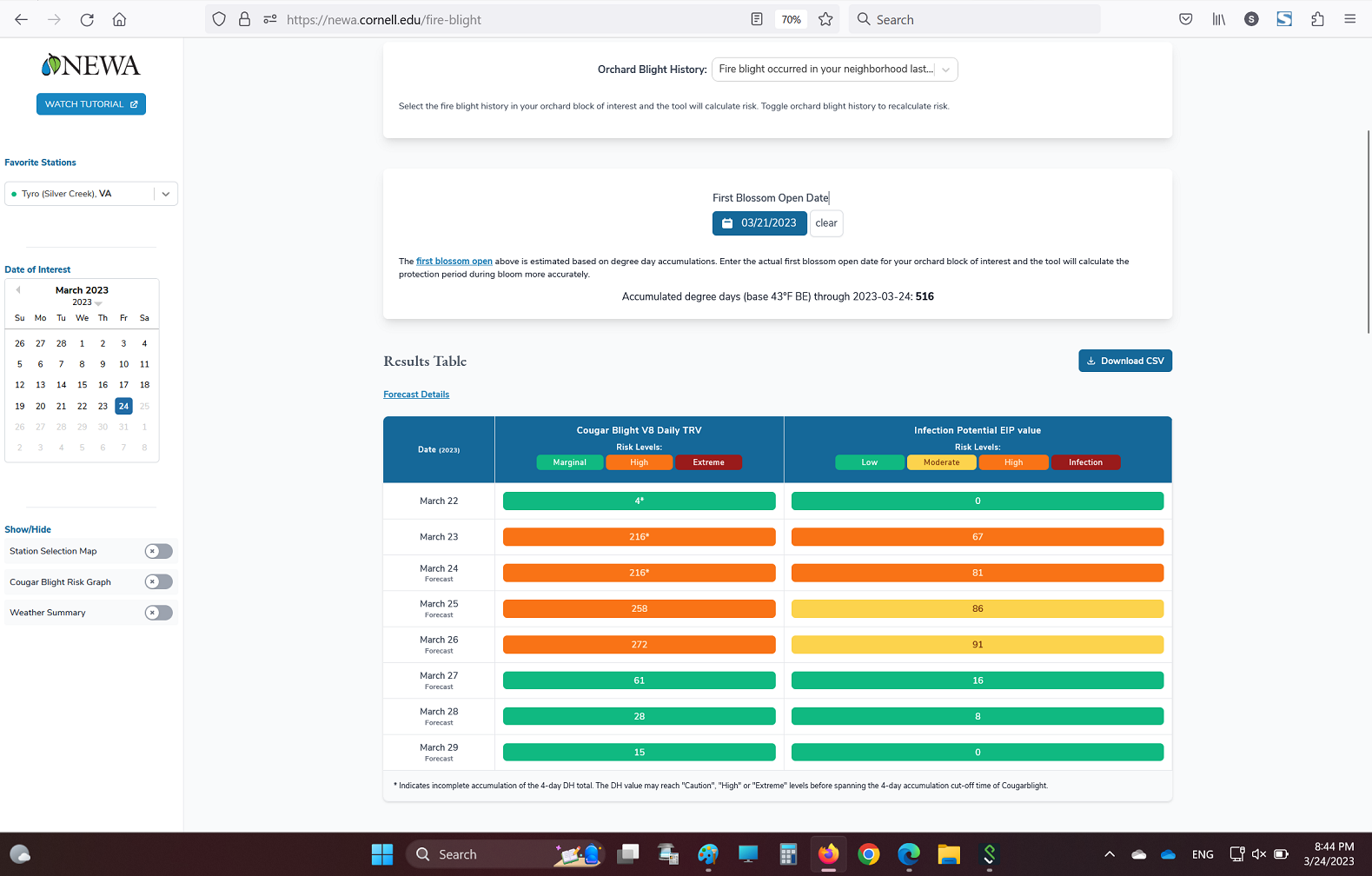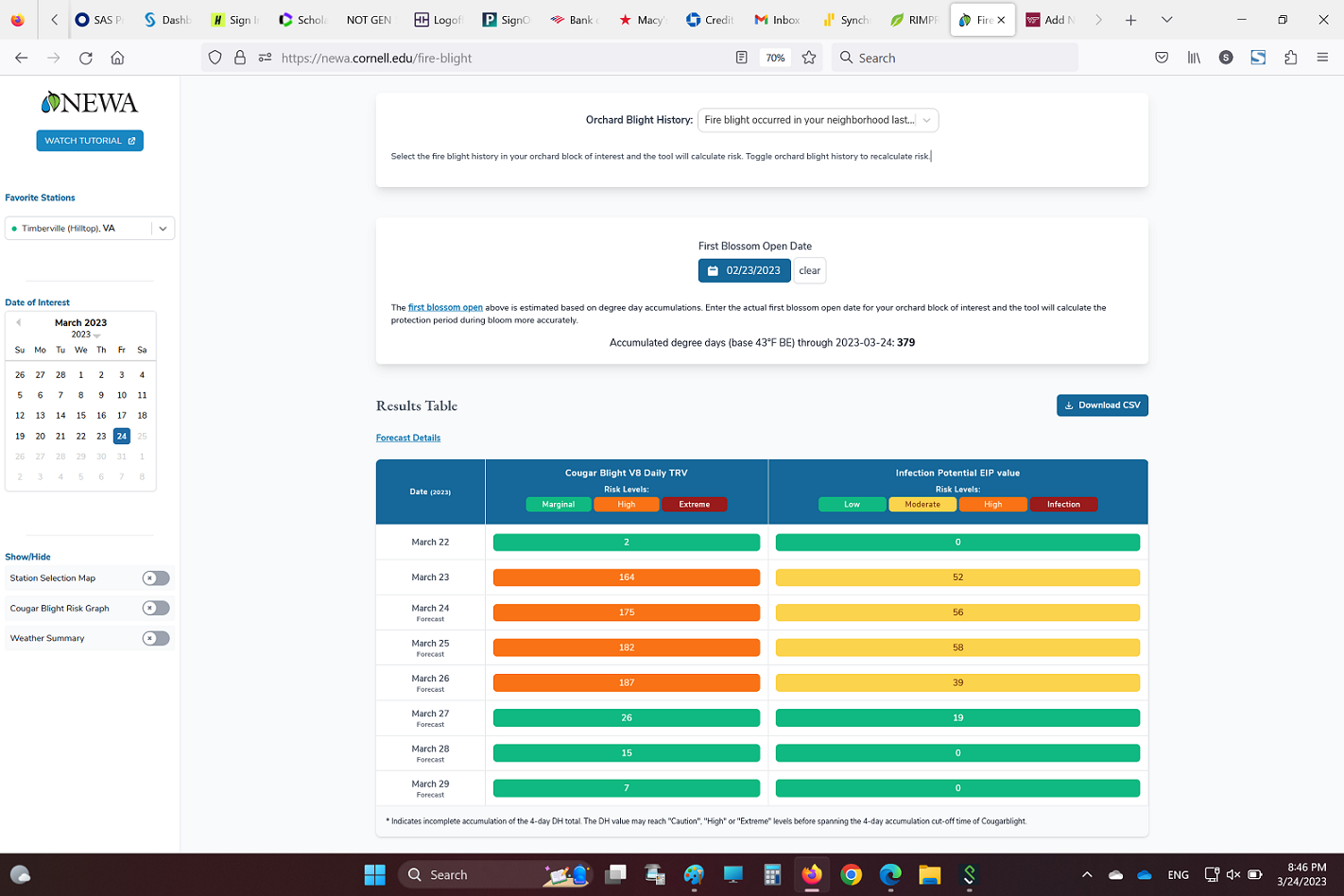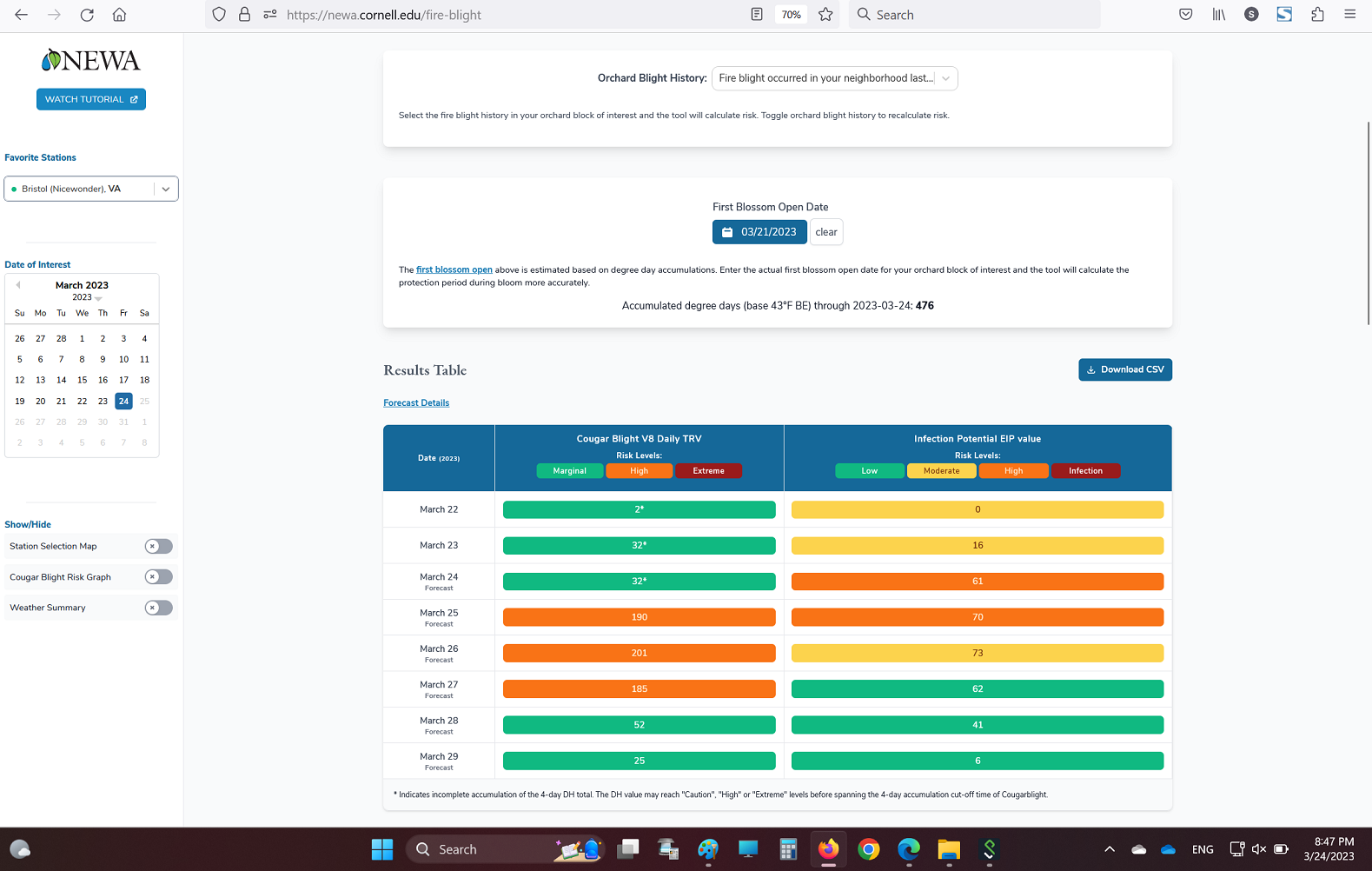Where Flowers Are Open near Rustburg, Fire Blight Infection Possible 25 March, But Infection Risk is Extremely Low for the Rest of Virginia
Most of central and southern Virginia farms I have communicated with today are at less then 1% bloom on Pink Lady, Hewe’s Crab, or other similar early cultivars. This is changing quickly as temperature rise, so keep looking a the EIP fire blight model in NEWA. Pears are likely more advanced in bloom and could be at risk from fire blight infection IF the EIP fire blight model in NEWA predicts that the infection is possible. For infection to occur ALL of the following factors listed below in bullets must occur at the same time:
- Open(ing), i.e. young flowers (on pear or apple)
- A certain number of heat units must accumulate during bloom for a threshold level of fire blight bacterium inoculum to be reached (EIP of 100 or above);
- A wetting event is necessary after this point to wash the bacteria to their infection sites;
- The average temperature is above 60F.
The colors in the NEWA fire blight EIP model column to the right in print screens below labeled “Infection Potential EIP value” reflect the combination of the required conditions in the bullets 1 to 4 above, and yes, for infection to occur you need all conditions in bullets 1 to 4 to coincide while trees are in bloom. Therefore, the box with EIP value needs to turn into dark red color to tell you the infection will occur with a natural wetting event (if you are providing water with the spray application of a fungicide, insecticide, or a thinner, you can trigger the infection but the model will not account for that as it uses natural and not human caused wetting events to give infection predictions). Here are the color codes and what they mean:

Now back to what is happening now in Virginia: as per the “Infection Potential EIP value” visible in the first print screen below the infection is only possible on 25 March in Rustburg VA (dark red field/s with EIP equal or above 100 in print screens below indicating “Infection”). The EIP value visible below in the right column “Infection Potential EIP value” is 109 for 25 March and the field turned in red indicating “Infection”. If the weather forecast remains the same as it is now, the infection will not occur at all other locations we monitor on the NEWA fire blight models in central and southern Virginia (EIP too low or other factors above missing), while in northern Virginia open flowers on pome fruit buds have not yet been observed (let me know if I am wrong). Therefore, based on print screens included below, only farms in and near Rustburg can decide whether to apply one of the two spray options against fire blight infection predicted for 25 March:
OPTION 1: preventive use of streptomycin – cover before the predicted wetting event any apple and pear trees in bloom with streptomycin: Harbor, or Agrimycin 17, or Fire Wall 17 WP at 1.5 to 1 lb per acre (16 – 24 oz/A) plus LI 700 at a penetrating rate or use Regulaid instead of LI700. Based on the Regulaid label you could use 2 pints penetrating rate. Keep in mind that FireWall has changed its formulation to FireWall 50WP and the rate to use this higher concentrated material is 8 – 16 oz/Acre. If you still have FireWall 17 WP in your shed use the rate of 24 – 48 oz/Acre as it is less concentrated. Option one is a must in large acreage apple and pear farms. If rain doesn’t occur, infection will occur if you provide water with a fungicide spray application, so if you are applying a previously planned fungicide application – add streptomycin to it.
OPTION 2: kick-back use of streptomycin – Only use it if you must, i.e. you are willing to risk: if you have a smaller acreage farm with apples or pears in bloom, you could wait and see will you get the wetting event or not on 25 March, because the rains events might be spotty and occur on one location and not on the other. So, if you get the rain events on the 25 March infection will occur and you will need to cover with streptomycin up to 24 h after the triggering rain event has started. Apply streptomycin in mix with Regulaid or LI700 up to 24 h after the infection rain event started (kick-back mode of application). In case you will use LI700 instead of Regulaid, use a penetrating action rate for LI700. If rain doesn’t occur, infection will not occur, unless you provide(d) water with a fungicide spray application near the infection dates, which can and will trigger the infection – so if you plan fungicide application add streptomycin to it.
NOTE: EIP means Epiphytic Infection Potential, which is the measure of how much heat units have accumulated which directly impact growth of fire blight bacteria populations on the surface of open flowers (so Epiphytic in EIP means that fire blight bacteria multiply on the surface of the flowers). Fire blight bacteria multiply at temperatures above 65 F. Accumulated degree hours of heat above 65 F (DH65) estimate bacterial population growth on the flower surface to a dangerous level that is necessary to exist before infection is possible. At the 198 degree hours accumulation of heat above 65 F, during the time when flowers are opening, fire blight bacteria populations have reached critically high enough numbers that could cause infection if wetting event on flowers occurs (The EIP value results from dividing the current accumulated heat units i.e. degree hours or DH above 65F by 195 and then multiplying this by 100). For example: EIP when 198 DH / 195 = 101. To infect flowers, the high bacterial populations on flowers require a wetting event – either rain, or heavy dew, or spray water from your tank (if you apply fungicides, insecticides, thinners) when EIP is at or above 100. Water washes the bacteria from the flower surface to the base of the flower where infection occurs through nectar glands. Therefore, if you are applying any spray mix to protect against rust, for example, when EIP is 100 or above, add streptomycin to your tank mix to prevent fire blight infection.




